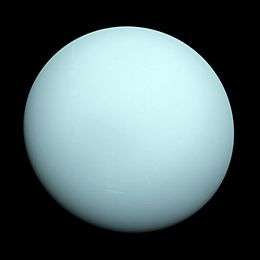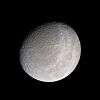Ophelia (moon)
|
Discovery image of Ophelia (top of image, outside of rings) | |
| Discovery | |
|---|---|
| Discovered by | Richard J. Terrile / Voyager 2 |
| Discovery date | January 20, 1986 |
| Orbital characteristics | |
Mean orbit radius | 53,763.390 ± 0.847 km[1] |
| Eccentricity | 0.00992 ± 0.000107[1] |
| 0.37640039 ± 0.00000357 d[1] | |
Average orbital speed | 10.39 km/s[lower-alpha 1] |
| Inclination | 0.10362 ± 0.055° (to Uranus' equator)[1] |
| Satellite of | Uranus |
| Physical characteristics | |
| Dimensions | 54 × 38 × 38 km[2] |
Mean radius | 21.4 ± 4 km[2][3][4] |
| ~6600 km²[lower-alpha 1] | |
| Volume | ~41,000 km³[lower-alpha 1] |
| Mass | ~5.3×1016 kg[lower-alpha 1] |
Mean density | ~1.3 g/cm³ (assumed)[3] |
| ~0.0070 m/s²[lower-alpha 1] | |
| ~0.018 km/s[lower-alpha 1] | |
| synchronous[2] | |
| zero[2] | |
| Albedo | |
| Temperature | ~64 K[lower-alpha 1] |
|
| |
Ophelia (/oʊˈfiːljə/[6][7] o-FEEL-yə) is a moon of Uranus. It was discovered from the images taken by Voyager 2 on January 20, 1986, and was given the temporary designation S/1986 U 8.[8] It was not seen until the Hubble Space Telescope recovered it in 2003.[5][9] Ophelia was named after the daughter of Polonius, Ophelia, in William Shakespeare's play Hamlet. It is also designated Uranus VII.[10]
Other than its orbit,[1] radius of 21 km[2] and geometric albedo of 0.08[5] virtually nothing is known about it. At the Voyager 2 images Ophelia appears as an elongated object, the major axis pointing towards Uranus. The ratio of axes of the Ophelia's prolate spheroid is 0.7 ± 0.3.[2]
Ophelia acts as the outer shepherd satellite for Uranus' Epsilon ring.[11] The orbit of Ophelia is within the synchronous orbit radius of Uranus, and therefore the moon is slowly decaying due to tidal forces.[2]
See also
References
Explanatory notes
Citations
- 1 2 3 4 5 Jacobson, R. A. (1998). "The Orbits of the Inner Uranian Satellites From Hubble Space Telescope and Voyager 2 Observations". The Astronomical Journal. 115 (3): 1195–1199. Bibcode:1998AJ....115.1195J. doi:10.1086/300263.
- 1 2 3 4 5 6 7 Karkoschka, Erich (2001). "Voyager's Eleventh Discovery of a Satellite of Uranus and Photometry and the First Size Measurements of Nine Satellites". Icarus. 151 (1): 69–77. Bibcode:2001Icar..151...69K. doi:10.1006/icar.2001.6597.
- 1 2 3 "Planetary Satellite Physical Parameters". JPL (Solar System Dynamics). 24 October 2008. Retrieved 12 December 2008.
- 1 2 Williams, Dr. David R. (23 November 2007). "Uranian Satellite Fact Sheet". NASA (National Space Science Data Center). Retrieved 12 December 2008.
- 1 2 3 Karkoschka, Erich (2001). "Comprehensive Photometry of the Rings and 16 Satellites of Uranus with the Hubble Space Telescope". Icarus. 151 (1): 51–68. Bibcode:2001Icar..151...51K. doi:10.1006/icar.2001.6596.
- ↑ "Ophelia". Merriam-Webster Dictionary. Retrieved 2016-01-22.
- ↑ "Ophelia". Dictionary.com Unabridged. Random House. Retrieved 2016-01-22.
- ↑ Smith, B. A. (1986-01-27). "Satellites and Rings of Uranus". IAU Circular. 4168. Retrieved 2011-10-31.
- ↑ Showalter, M. R.; Lissauer, J. J. (2003-09-03). "Satellites of Uranus". IAU Circular. 8194. Retrieved 2011-10-31.
- ↑ "Planet and Satellite Names and Discoverers". Gazetteer of Planetary Nomenclature. USGS Astrogeology. July 21, 2006. Retrieved 6 August 2006.
- ↑ Esposito, L. W. (2002). "Planetary rings". Reports On Progress In Physics. 65 (12): 1741–1783. Bibcode:2002RPPh...65.1741E. doi:10.1088/0034-4885/65/12/201.


